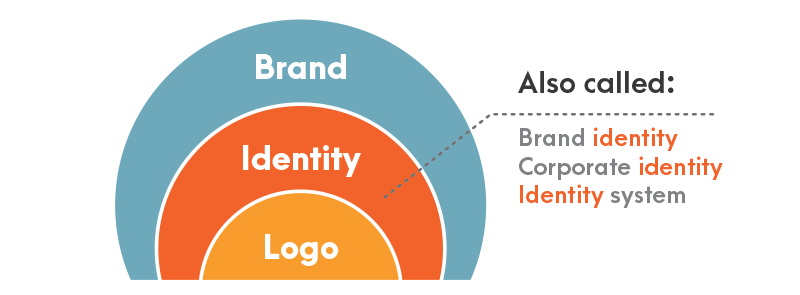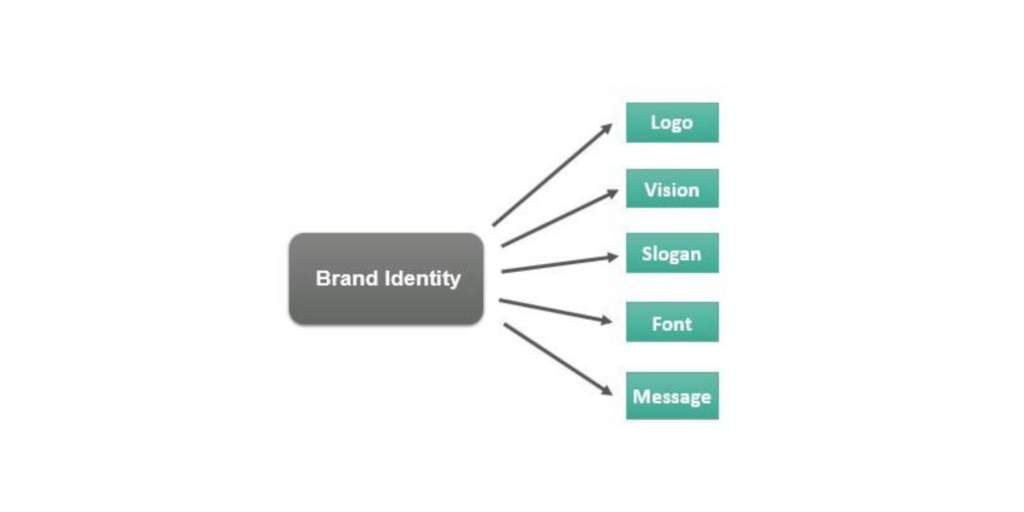Understanding and harnessing brand identity is pivotal, especially given the prevalent confusion surrounding this concept. The misuse of brand terminology in the media and marketing industry contributes to this confusion. However, brand identity, with its specific meaning, serves as a potent instrument for shaping public perception of your firm. Mastering brand identity is crucial for enhancing your firm’s image and influencing how people perceive it.
What Is Brand Identity

Brand identity constitutes the visual, and to a lesser extent, verbal manifestation of your brand. It encompasses eight integral components:
- Company name
- Logo
- Tagline
- Color Palette
- Typography
- Graphical Elements
- Imagery
- Voice
Deploying brand identity strategically provides visual cues that communicate positive qualities, alleviating concerns individuals may have about your brand. These cues, often difficult to articulate, exert psychological persuasion. For instance, a sleek and modern identity can convey attention to detail and credibility.
When combined with other information, such as messaging on your website or presentations by key figures, these cues contribute to building positive sentiments. This, in turn, fosters trust and associates your firm with specific attributes, like expertise, service offerings, or successful outcomes.
Brand identity also plays a crucial role in differentiation, a challenge particularly pertinent to professional services firms. A distinctive identity captures attention and encourages prospective clients to take a closer look.
Distinguishing Brand Identity from a Brand

While brand identity represents the visual facet of a brand, the brand itself is the collective perception and experience of the firm. Jeff Bezos succinctly captures this: “A brand is what other people say about you when you aren’t in the room.” Brand identity, as an input, collaborates with differentiators, brand positioning, personality, and messaging to shape this output. Other factors, such as customer service, reviews, and alignment with promised experiences, also influence the brand.
Elements of Brand Identity

Now, let’s delve into the components of brand identity, each playing a unique yet synergistic role. While some firms develop their visual brand without a strategic focus, those who understand the potential of each component can craft a compelling, persuasive brand identity.
- Name:
- Essential to marketing, your business name is the primary identifier.
- Choosing a name involves navigating various considerations like trademark conflicts, originality, pronunciation, spelling, URL availability, and semantics.
- A strong name is short, memorable, and distinct from competitors, often abstract or evocative.
- Logo:
- One of the most visible components, the logo is instantly recognizable.
- A logo serves to identify, differentiate, and aid recall.
- Consider rebranding if your current logo hinders your brand’s potential.
- Tagline:
- While not mandatory, a tagline can be valuable if it clarifies, expresses brand attributes, articulates positioning, or aids memorability.
- Color Palette:
- Emotionally engaging, color is a critical tool for differentiation and setting the brand mood.
- Strategic color choices, driven by brand strategy, are more effective than emotional preferences.
- Typography:
- Often overlooked, typefaces contribute to sophistication.
- Choices involve considerations of personality, approachability, distinctiveness, readability, and modernity.
- Graphical Elements:
- Some brands use a defining graphical device for consistency across materials.
- PricewaterhouseCoopers’ logo is an example of a flexible graphical element.
- Imagery:
- Visuals, when strategically chosen, can create a distinctive and memorable brand identity.
- Benetton’s use of graphic, editorial-style photos in advertisements is a noteworthy example.
- Voice:
- Verbal communication, or voice, is a crucial component of brand identity.
- Consistency in tone and language aligns with the overall brand strategy.
Brand Style Guidelines & Enforcement
Documenting brand identity and creating guidelines ensures consistency and longevity. These guidelines cover logo usage, tagline usage, color palette, typography, imagery, graphical elements, layout guidance, environmental signage, vehicle graphics, apparel, and tone and voice. While guidelines should strike a balance between detail and flexibility, enforcement is crucial to maintaining brand integrity.
Birdland is a prime example of a well design brand identity, the brand has created a strong brand image, which is recognizable and powerful.

Conclusion:
Given humans’ visual nature, brand identity becomes a potent tool for differentiation and creating positive associations. A well-thought-out identity system, grounded in strategy, leaves a lasting impression at every touchpoint in business development and client delivery. Understanding and leveraging brand identity can transform your firm’s image and influence perceptions positively.